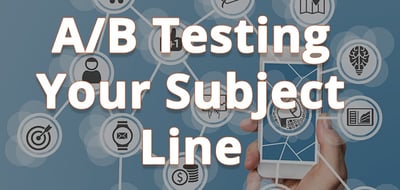 If you are not A/B testing your subject lines, you are wasting the chance to test on a captive audience. With email you have an advantage in that the people on your email list have already expressed interest in you in some way or another—perhaps they have given you their address in exchange for content or they’ve signed up to receive updates on specific topics.
If you are not A/B testing your subject lines, you are wasting the chance to test on a captive audience. With email you have an advantage in that the people on your email list have already expressed interest in you in some way or another—perhaps they have given you their address in exchange for content or they’ve signed up to receive updates on specific topics.
Regardless, now that you have them, you need subject lines that wow and compel readers to open your message and take the next step. A/B testing subject lines is the perfect way to see which words or offers are working and which ones are not. In fact, Unbounce thinks that subject lines are the most important part of your email.
Make a Decision
Since there are many elements of email marketing you can (and should) A/B test, first decide what you want to test and why. In this case, we are focusing on subject lines, but other options include CTAs, headlines, greeting, offer, and landing pages.
When it comes to A/B testing subject lines is particular, determine what you are hoping to learn. You can do this by first taking a look at past campaigns that have failed or succeeded and studying the different subject line approaches you have tried. Unless you test and measure, you don’t truly know what does/does not work. For example, there is a popular belief that shorter subject lines are preferable, but testing often proves this to be inbound urban legend.
Length and Language
When it comes to subject lines, it is not just the offer that determines whether or not someone will or will not open the message. It is not necessarily what you are saying, but how you are saying it that can make all the difference.
People respond differently to different words and tones. This is where buyer personas can offer insight into the type of approach to test with a specific audience. Remember, how you deliver the message can be just as important as the message itself.
Specific Considerations
So, now that you know what you want to test and how to go about it, get even more targeted with subject line. Consider:
• Do numbers or amounts work better than just text? Do they increase open rates?
• Do my recipients prefer personalization? How personal? First name or other?
• Is a statement or questions preferable? Which resonates more with readers.
• Short and sweet or long and detailed?
Now you can get creative with your language and offer. Group A: Enjoyed your last purchase? Great! Here is 20% off your next one. Group B: As a thank you for your recent purchase, we have a great offer for you. Both are similar in length, follow-up to previous buyers, and contain an offer. The primary difference is that one lists a specific numerical offer and the other alludes to the offer.
Segment Your List
Are you going to test your entire list or target a specific segment? That depends on your company, the size of your list, and your ability to segment to a partial level of detail. The ideal segment must be measurable and a viable group to reach/target via email communication. In the example above, the list was segmented into recipients who have previously made a purchase, which is considered a “concentration strategy,” meaning that it focuses only on one segment, versus a “multi-segment strategy.” Segmentation can be done my demographic, geographic, lifestyle, behavior, and other categories.
Measure Success
Success comes in different forms; however, regardless of what you hope to achieve, you must measure the campaign into to determine what did/did not work. When A/B testing subject lines, the most common items to measure are: open rate, click-through rate, and subsequent conversion rate.
Studying test results you should be able determine which subject line was more effective in terms of open rate. But how does that affect click-through and conversion? To capture the full picture, you must compare the open rate for each segment to the click-through rate—did the same group who opened more click more? And furthermore, out of all of those who clicked through, how many converted? Look for correlations and differences between the results from the two different subject line segments.
When it comes to A/B testing subject lines, marketers frequently discover the unexpected. And, just as often, the reasons that A or B is preferable is not necessarily based on the “rules” of email marketing. So get testing, and get selling.
What A/B test results have been the most surprising to you? Leave a comment below and let us know what you learned from testing. If you enjoyed reading this blog then check out our Business Blogging Tips ebook too!
